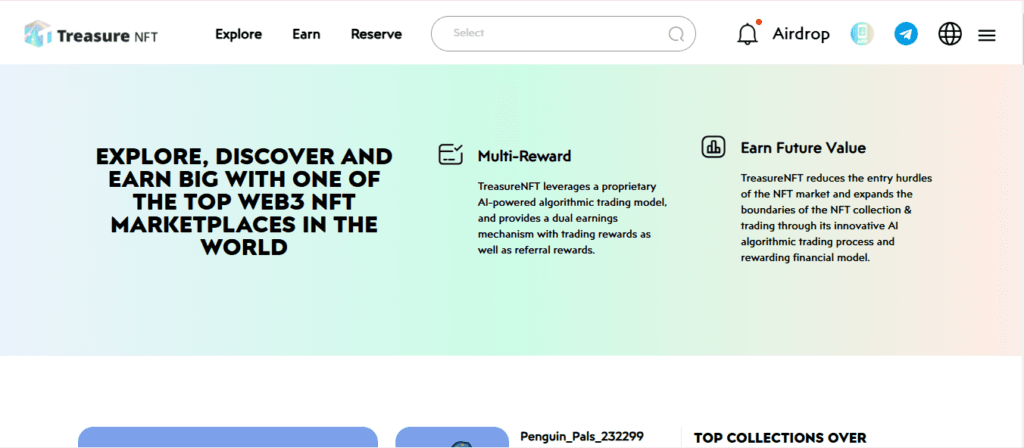Treasure NFT is a fraudulent platform masquerading as a legitimate NFT marketplace, leveraging Ponzi schemes and fake reviews to exploit users.
Promising high returns through AI-driven trading and referrals, it lacks transparency, regulatory compliance, and sustainable operations.
In this article, we dissect its deceptive tactics, analyze user experiences, and provide actionable steps to avoid such scams.
Understanding Treasure NFT’s Claims
Treasure NFT positions itself as a Web3 platform where users earn through NFT trading and referrals.
Its website highlights AI-powered algorithms, multi-language support, and dual rewards (trading income + referral commissions). However, these claims crumble under scrutiny.
The Platform’s Promises vs. Reality
While the platform advertises “30% monthly returns” and “risk-free earnings,” these guarantees are mathematically implausible.
Legitimate NFT marketplaces generate revenue through organic trading volume, not recruitment.
Treasure NFT’s focus on referral bonuses over genuine NFT liquidity exposes its Ponzi foundation.

Critical Red Flags Proving Treasure NFT is a Scam
Anonymous Leadership and Zero Accountability
A legitimate business operates transparently. Treasure NFT, however, provides no verifiable details about its founders, team, or physical office.
The website’s footer vaguely references “TreasureMeta Technology, Inc,” but no corporate records or regulatory filings validate its existence.
This anonymity shields scammers from legal repercussions.
Unrealistic Returns and Ponzi Mechanics
Ponzi schemes rely on new investments to pay old users, not real revenue. Treasure NFT’s 4.3%-6.8% daily returns defy market logic.
For context, even high-performing crypto assets rarely yield 5% monthly. The platform’s referral system—rewarding users for recruiting “three generations” of members—confirms its pyramid structure.
Fake Reviews and Manipulated Ratings
Treasure NFT’s 4.7/5 rating on Google Play and 4.4/5 on Trustpilot are artificially inflated.
Google Play Store Deception
Over 40,000 reviews appear suspiciously generic. Examples include:
- “This app work properly” (repeated verbatim).
- “I have account and now I am happy” (grammatically inconsistent).
Negative reviews reveal systemic issues:
- “Withdrawal dena band kr gayi h scam… 10 din se $20000 ka withdraw pending.”
- “They freeze accounts unless you recruit 50 people.”
Trustpilot’s Fraud Detection
Trustpilot flagged and removed fake reviews, stating: “We’ve detected and removed a number of fake reviews for this company.” New profiles with identical 5-star ratings emerged post-scrutiny, further proving manipulation.
Withdrawal Restrictions and Financial Traps
Users report:
- 5% withdrawal fees and $50 minimums, draining small investors.
- Indefinite “pending” withdrawals or sudden account freezes.
- Funds released only after recruiting new members, a tactic to prolong the scam.
Lack of Regulatory Licenses
Treasure NFT claims an MSB (Money Services Business) license but provides no registration number or regulatory body details.
Legitimate platforms like Coinbase or Binance openly share licensing information from authorities like FINTRAC or FCA.
The Anatomy of Treasure NFT’s Scam Strategy
Ponzi Structure: Recruitment Over Revenue
The platform’s survival depends on constant recruitment. Early users receive payouts to create authenticity, but later investors fund these “returns.” Once recruitment slows, withdrawals halt, and the scheme collapses.
Influencer-Driven Hype
Treasure NFT collaborates with social media influencers on YouTube, TikTok, and Instagram to amplify its credibility. These promoters often:
- Use referral links for commission.
- Downplay risks while exaggerating earnings.
- Delete critical comments to maintain a curated facade.
Fabricated NFT Listings
The platform’s “top collections” (e.g., “Giffgaff Ape Club” or “Pixels Punk”) lack verifiable transaction histories on blockchain explorers like Etherscan.
This suggests fake liquidity—NFTs listed are either nonexistent or artificially priced.
User Experiences: Voices From Victims
Account Freezes and Lost Funds
- “I deposited $100… withdrawal pending for 8 days. No response from support.”
- “My $210 principal is stuck. They demand 50 recruits for withdrawals.”
Geographic Discrimination
African and South Asian users report deliberate delays and harsher recruitment quotas. One victim noted: “If someone in your group complains, the whole group is punished.”
Psychological Manipulation
The platform uses FOMO (Fear of Missing Out) tactics, displaying fake countdowns like “Earn Future Value—Sign Up Now!” to pressure sign-ups.
How to Protect Yourself From NFT Scams
Verify Regulatory Compliance
Legitimate platforms display licenses from SEC, FCA, or CySEC. Cross-check registration numbers on official government portals.
Scrutinize Unrealistic Returns
If a platform promises “risk-free” profits exceeding 5% monthly, treat it as a scam alert. Sustainable returns require market-driven revenue, not recruitment.
Avoid Referral-Centric Platforms
Earnings dependent on multi-level marketing (MLM) are unsustainable. Prioritize platforms where income stems from organic trading or staking.
Use Secure Wallets
Store NFTs in self-custody wallets like MetaMask or Ledger, avoiding third-party platforms with withdrawal restrictions.
Legal Recourse for Scam Victims
Document Everything
Preserve screenshots of transactions, chat logs, and wallet addresses. This evidence is critical for filing reports.
Report to Authorities
- U.S. Victims: File complaints with the FTC or Internet Crime Complaint Center (IC3).
- EU/UK Victims: Contact Action Fraud or Europol.
- Asian Victims: Report to local cybercrime cells or financial regulators.
Class-Action Lawsuits
Collaborate with other victims to pursue collective legal action. While recovery is challenging, lawsuits can pressure scammers and freeze assets.
Final Thoughts: Navigating the NFT Space Safely
Treasure NFT epitomizes the dangers of unregulated crypto platforms. Its lack of transparency, fabricated reviews, and Ponzi mechanics confirm it’s a scam.
Always prioritize due diligence: verify licenses, avoid MLM models, and trust independent audits over influencer hype.
By staying informed, investors can safeguard their assets and contribute to a safer digital ecosystem.
Check Similar Crypto Platform Review: Is Xdex.top Real or Fake?
Frequently asked Questions
How does Treasure NFT’s scam work?
Treasure NFT operates as a Ponzi scheme, using new deposits to pay old users. Profits depend on recruitment, not trading.
Why do some users get payouts?
Early investors receive “returns” from later victims to build credibility. These payouts stop once recruitment slows.
Is the AI trading real?
No. The platform provides zero proof of AI algorithms or trading activity. Listings are fabricated.
Why isn’t Treasure NFT shut down?
Scammers use fake domains and offshore hosting to evade authorities. Report them to hasten action.
Are there legitimate NFT platforms?
Yes. Platforms like OpenSea, Rarible, and Magic Eden are regulated and transparent.
